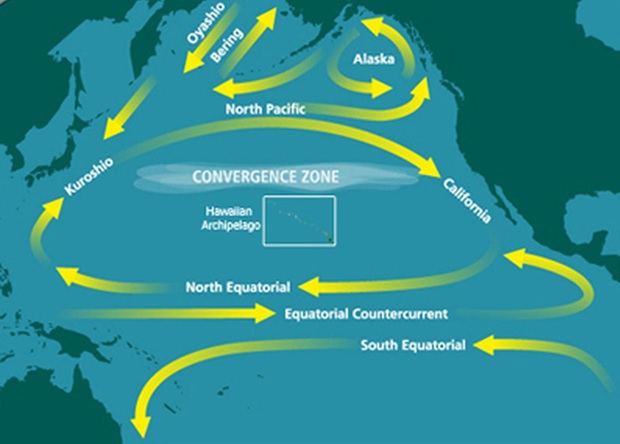(MainsGS3: Conservation, environmental pollution and degradation, environmental impact assessment.)
Context:
- Recently researchers from Canada, the Netherlands, and the U.S. have reported that coastal lifeforms have colonised plastic items in the Great Pacific Garbage Patch.
About Great Pacific Garbage Patch:
- There are some water currents in the oceans that, driven by winds and the Coriolis force, form loops which are called gyres.
- The North Pacific Subtropical Gyre (NPSG) is one such, located just north of the equator in the Pacific Ocean.
- It consists of the Kuroshio, North Pacific, California, and North Equatorial currents and moves in a clockwise direction.
- These currents flow adjacent to 51 Pacific Rim countries and any trash that enters one of these currents, from any of these countries, could become part of the gyre.
- Inside this gyre, just north of Hawai’i, lies a long east-west strip where some of the debris in these currents has collected over the years. The eastern part of this is the Great Pacific Garbage Patch.
- The patch contains an estimated 45,000-1,29,000 metric tonnes of plastic, predominantly in the form of microplastics.
- The numerical density of plastics here is around 4 particles per cubic metre.
- Mass-wise, however, heavier, more visible objects that haven’t yet broken down into smaller particles accounted for 92% in 2018.

Findings of new study:
- The tsunami off the Japanese coast in 2011 contributed to the debris in this garbage patch.
- Until at least 2017, researchers had found debris washing ashore on the West coast of North America containing live life forms originally found in Japan.
- From November 2018 to January 2019, researchers collected 105 pieces of plastic debris from the eastern part of the NPSG, “the most heavily plastic-polluted ocean gyre on the globe.
- Based on studying them, they reported that 98% of the debris items had invertebrate organisms.
- They also found that pelagic species (i.e. of the open ocean) were present on 94.3% of them and coastal species, on 70.5%.
- That is, organisms found on coasts were getting by on small floating islands of garbage (to humans) out in the Pacific Ocean.
Importance of findings:
- The introduction of a vast sea of relatively permanent anthropogenic rafts since the 1950s” has given rise to a new kind of “standing coastal community … in the open ocean”. They’ve named it the neopelagic community.
- While coastal species have been found on human-made objects in the open ocean before, they were always considered to have been “misplaced” from their intended habitats.
- The neopelagic community, on the other hand, is not misplaced but lives on plastic items in the garbage patch, including reproducing there.




